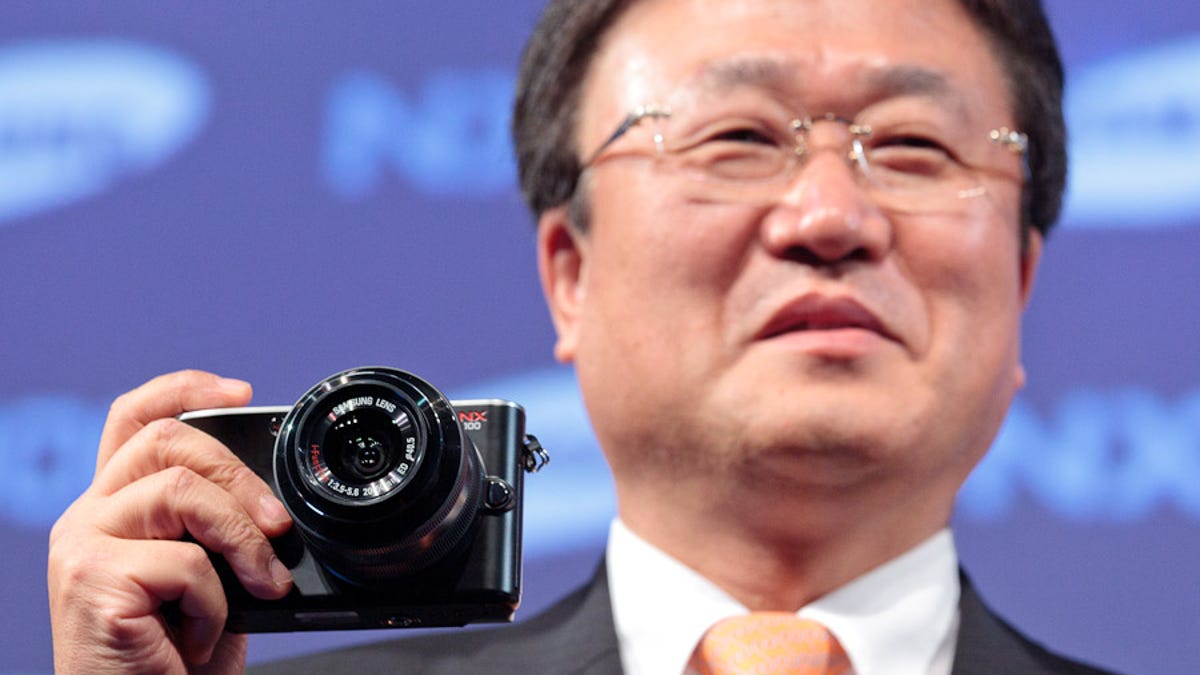Samsung flexes young photo muscles with NX100
The Korean electronics giant is betting that the user interface on its new NX100 interchangeable-lens cameras will make the company an imaging power.

COLOGNE, Germany--Samsung, showing off its new higher-end compact NX100 camera, declared its ambition Monday to become a power in the camera industry.
"I believe the NX100 will be the catalyst for photo innovations in the digital camera industry and will propel Samsung forward to become one of the world's leading manufacturers," said Sangjin Park, president of Samsung's digital imaging division, speaking at press event at the Photokina show here.
Compact ILC (interchangeable lens camera) models are all the rage as the industry seeks to build new demand in a somewhat saturated market. Olympus and Panasonic led the way with their compatible Micro Four Thirds models, and Samsung and Sony have now arrived with models of their own featuring a larger sensor and their own proprietary lens mounts. These higher-end models aren't cheap: Samsung's costs $599 with a 20-50mm lens and $649 with a 20mm lens.
The ILC trend is still in its early days, though, and InfoTrends analyst Ed Lee believes it'll take the arrival of the industry's high-end camera powerhouses, Canon and Nikon, to truly legitimize the market.
But Samsung isn't waiting. Front and center in the effort to make more usable cameras is a new feature called i-Function to control camera settings that the company hopes will attain that holy grail, a camera that's easy to use but that offers a wealth of creative possibilities. Control over details such as shutter speed and aperture has never been simple, but Samsung promises i-Function will be different.
It works through a button on the side of an i-Function-compatible lens, of which Samsung plans a range that begins with a 20mm f2.8 pancake and a 20-50mm f3.5-5.6 zoom. Pushing the button cycles through various parameters that can be set--shutter speed, aperture, ISO, and exposure compensation--while turning the lens' focus ring changes the setting.
The overall operation can be performed without moving the hands to any number of buttons and scroll wheels, Park said.
"Amateurs and professionals can take perfect pictures by making the most of these variable functions easily," Park said. "We have taken all the image technology, encased it in a stylish, slim, and portable body, and created new ways to improve people's photography experience."
Whether it will live up to that ambitious promise remains to be seen, but Samsung clearly is invested in the imaging business, and its NX designs fit more naturally with Samsung's electronics ethos than an earlier foray that relied on more traditional Pentax-designed SLR bodies.
The Korean manufacturer also has gained experience since those earlier days. It has at times relied on help from lens expert Schneider Kreutznach for optical expertise, but all the i-Function lenses will be designed by Samsung itself.
The promise of interchangeable lens cameras is only as good as the range available, and more are on the way. In the first half of 2011 will come a "movie pro" model with a 18-200mm range and f3.5-6.3 aperture and a 60mm f2.8 macro, both optically stabilized. In the second half of 2011 will come a "movie home" with a 16-80mm range and f3.5-4.5 aperture, a 16mm f2.8 pancake, and an 85mm portrait lens.
Also coming are new cameras with a better image sensor due in 2011, Park said. "We ware working on a new generation of sensors," and those cameras will be able to shoot 1080p video. The NX100 are limited to 720p.
Samsung debuted its first NX model, the NX10, in January. It's larger than the NX100 and geared toward a more experienced buyer.

